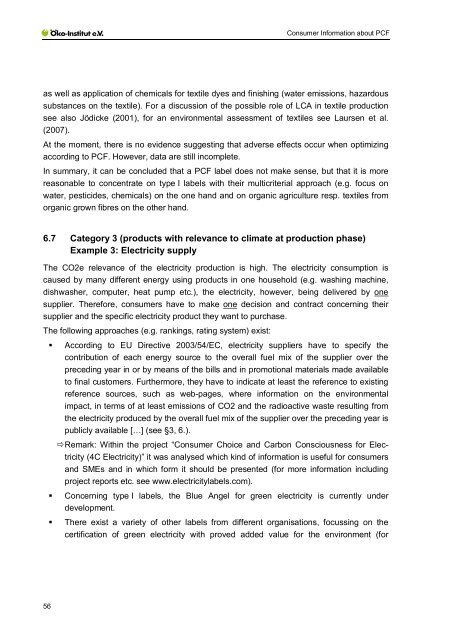Requirements on Consumer Information about Product ... - ANEC
Requirements on Consumer Information about Product ... - ANEC
Requirements on Consumer Information about Product ... - ANEC
Create successful ePaper yourself
Turn your PDF publications into a flip-book with our unique Google optimized e-Paper software.
C<strong>on</strong>sumer Informati<strong>on</strong> <strong>about</strong> PCF<br />
as well as applicati<strong>on</strong> of chemicals for textile dyes and finishing (water emissi<strong>on</strong>s, hazardous<br />
substances <strong>on</strong> the textile). For a discussi<strong>on</strong> of the possible role of LCA in textile producti<strong>on</strong><br />
see also Jödicke (2001), for an envir<strong>on</strong>mental assessment of textiles see Laursen et al.<br />
(2007).<br />
At the moment, there is no evidence suggesting that adverse effects occur when optimizing<br />
according to PCF. However, data are still incomplete.<br />
In summary, it can be c<strong>on</strong>cluded that a PCF label does not make sense, but that it is more<br />
reas<strong>on</strong>able to c<strong>on</strong>centrate <strong>on</strong> type I labels with their multicriterial approach (e.g. focus <strong>on</strong><br />
water, pesticides, chemicals) <strong>on</strong> the <strong>on</strong>e hand and <strong>on</strong> organic agriculture resp. textiles from<br />
organic grown fibres <strong>on</strong> the other hand.<br />
6.7 Category 3 (products with relevance to climate at producti<strong>on</strong> phase)<br />
Example 3: Electricity supply<br />
The CO2e relevance of the electricity producti<strong>on</strong> is high. The electricity c<strong>on</strong>sumpti<strong>on</strong> is<br />
caused by many different energy using products in <strong>on</strong>e household (e.g. washing machine,<br />
dishwasher, computer, heat pump etc.), the electricity, however, being delivered by <strong>on</strong>e<br />
supplier. Therefore, c<strong>on</strong>sumers have to make <strong>on</strong>e decisi<strong>on</strong> and c<strong>on</strong>tract c<strong>on</strong>cerning their<br />
supplier and the specific electricity product they want to purchase.<br />
The following approaches (e.g. rankings, rating system) exist:<br />
• According to EU Directive 2003/54/EC, electricity suppliers have to specify the<br />
c<strong>on</strong>tributi<strong>on</strong> of each energy source to the overall fuel mix of the supplier over the<br />
preceding year in or by means of the bills and in promoti<strong>on</strong>al materials made available<br />
to final customers. Furthermore, they have to indicate at least the reference to existing<br />
reference sources, such as web-pages, where informati<strong>on</strong> <strong>on</strong> the envir<strong>on</strong>mental<br />
impact, in terms of at least emissi<strong>on</strong>s of CO2 and the radioactive waste resulting from<br />
the electricity produced by the overall fuel mix of the supplier over the preceding year is<br />
publicly available […] (see §3, 6.).<br />
ð Remark: Within the project “C<strong>on</strong>sumer Choice and Carb<strong>on</strong> C<strong>on</strong>sciousness for Electricity<br />
(4C Electricity)” it was analysed which kind of informati<strong>on</strong> is useful for c<strong>on</strong>sumers<br />
and SMEs and in which form it should be presented (for more informati<strong>on</strong> including<br />
project reports etc. see www.electricitylabels.com).<br />
• C<strong>on</strong>cerning type I labels, the Blue Angel for green electricity is currently under<br />
development.<br />
• There exist a variety of other labels from different organisati<strong>on</strong>s, focussing <strong>on</strong> the<br />
certificati<strong>on</strong> of green electricity with proved added value for the envir<strong>on</strong>ment (for<br />
56
















